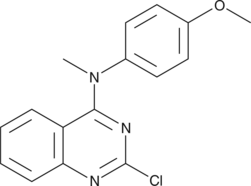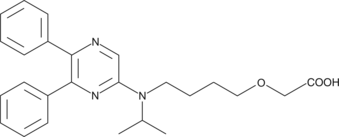Cayman
Showing 30451–30600 of 45550 results
-
Glutamate, the major excitatory neurotransmitter in the brain, acts on both ionotropic and metabotropic glutamate receptors. Excessive metabotropic glutamate receptor (mGluR) transmission has been linked to epilepsy, ischemia, pain, anxiety, and depression. Eight subtypes (1-8) and multiple splice variants of the mGluR have been identified and grouped based on their pharmacological properties. Group I mGluRs (subtypes 1 and 5) activate the phosphatidyl inositol pathway, while Group II (2 and 3) and Group III (4, 6, 7 and 8) inhibit adenylyl cyclase. MPEP is a potent, highly selective non-competitive antagonist at the mGlu5a receptor subtype (IC50 = 36 nM) while having no agonist or antagonist activities at the mGlu1b receptor at concentrations up to 30 μM.{22822} MPEP is centrally active following systemic administration in vivo, inducing anxiolytic-like effects in rodent models of anxiety and depression when administered at 1-30 mg/kg.{22822} MPEP has also been reported as a positive allosteric modulator of mGluR4 at μM concentrations.{22823}
Brand:CaymanSKU:- -
Glutamate, the major excitatory neurotransmitter in the brain, acts on both ionotropic and metabotropic glutamate receptors. Excessive metabotropic glutamate receptor (mGluR) transmission has been linked to epilepsy, ischemia, pain, anxiety, and depression. Eight subtypes (1-8) and multiple splice variants of the mGluR have been identified and grouped based on their pharmacological properties. Group I mGluRs (subtypes 1 and 5) activate the phosphatidyl inositol pathway, while Group II (2 and 3) and Group III (4, 6, 7 and 8) inhibit adenylyl cyclase. MPEP is a potent, highly selective non-competitive antagonist at the mGlu5a receptor subtype (IC50 = 36 nM) while having no agonist or antagonist activities at the mGlu1b receptor at concentrations up to 30 μM.{22822} MPEP is centrally active following systemic administration in vivo, inducing anxiolytic-like effects in rodent models of anxiety and depression when administered at 1-30 mg/kg.{22822} MPEP has also been reported as a positive allosteric modulator of mGluR4 at μM concentrations.{22823}
Brand:CaymanSKU:- -
MPI-0441138 is a potent inducer of apoptosis and growth inhibition (EC50 = 2 nM for both processes, based on caspase-3 activation and total cellular ATP, respectively) in T47D and HCT116 cells.{16623,32891} MPI-0441138 has excellent blood brain barrier penetration and is effective in mouse xenograft cancer models.{16623,32891}
Brand:CaymanSKU:- -
MPI-0441138 is a potent inducer of apoptosis and growth inhibition (EC50 = 2 nM for both processes, based on caspase-3 activation and total cellular ATP, respectively) in T47D and HCT116 cells.{16623,32891} MPI-0441138 has excellent blood brain barrier penetration and is effective in mouse xenograft cancer models.{16623,32891}
Brand:CaymanSKU:- -
MPI-0441138 is a potent inducer of apoptosis and growth inhibition (EC50 = 2 nM for both processes, based on caspase-3 activation and total cellular ATP, respectively) in T47D and HCT116 cells.{16623,32891} MPI-0441138 has excellent blood brain barrier penetration and is effective in mouse xenograft cancer models.{16623,32891}
Brand:CaymanSKU:- -
MPI-0441138 is a potent inducer of apoptosis and growth inhibition (EC50 = 2 nM for both processes, based on caspase-3 activation and total cellular ATP, respectively) in T47D and HCT116 cells.{16623,32891} MPI-0441138 has excellent blood brain barrier penetration and is effective in mouse xenograft cancer models.{16623,32891}
Brand:CaymanSKU:- -
MPI-0479605 is a potent and ATP-competitive inhibitor of the mitotic kinase MPS1 (IC50 = 1.8 nM).{38558} It is selective for MPS1 over a panel of 79 kinases at a concentration of 500 nM. MPI-0479605 induces time-dependent degradation of cyclin B and securin and decreases phosphorylation of BUBR1 resulting in failed cytokinesis in HeLa cells arrested by nocodazole (Item No. 13857). It also causes misalignment of chromosomes at the anaphase plate and aneuploidy in A549 cells and slows cell cycle progression of HCT116 and COLO 205 cells irrespective of p53 activity. MPI-0479605 (30-150 mg/kg) reduces tumor volume in an HCT116 mouse colon cancer xenograft model in a dose-dependent manner.
Brand:CaymanSKU:22136 -Out of stock
-
MPI-0479605 is a potent and ATP-competitive inhibitor of the mitotic kinase MPS1 (IC50 = 1.8 nM).{38558} It is selective for MPS1 over a panel of 79 kinases at a concentration of 500 nM. MPI-0479605 induces time-dependent degradation of cyclin B and securin and decreases phosphorylation of BUBR1 resulting in failed cytokinesis in HeLa cells arrested by nocodazole (Item No. 13857). It also causes misalignment of chromosomes at the anaphase plate and aneuploidy in A549 cells and slows cell cycle progression of HCT116 and COLO 205 cells irrespective of p53 activity. MPI-0479605 (30-150 mg/kg) reduces tumor volume in an HCT116 mouse colon cancer xenograft model in a dose-dependent manner.
Brand:CaymanSKU:22136 -Out of stock
-
MPI-0479605 is a potent and ATP-competitive inhibitor of the mitotic kinase MPS1 (IC50 = 1.8 nM).{38558} It is selective for MPS1 over a panel of 79 kinases at a concentration of 500 nM. MPI-0479605 induces time-dependent degradation of cyclin B and securin and decreases phosphorylation of BUBR1 resulting in failed cytokinesis in HeLa cells arrested by nocodazole (Item No. 13857). It also causes misalignment of chromosomes at the anaphase plate and aneuploidy in A549 cells and slows cell cycle progression of HCT116 and COLO 205 cells irrespective of p53 activity. MPI-0479605 (30-150 mg/kg) reduces tumor volume in an HCT116 mouse colon cancer xenograft model in a dose-dependent manner.
Brand:CaymanSKU:22136 -Out of stock
-
MPI-0479605 is a potent and ATP-competitive inhibitor of the mitotic kinase MPS1 (IC50 = 1.8 nM).{38558} It is selective for MPS1 over a panel of 79 kinases at a concentration of 500 nM. MPI-0479605 induces time-dependent degradation of cyclin B and securin and decreases phosphorylation of BUBR1 resulting in failed cytokinesis in HeLa cells arrested by nocodazole (Item No. 13857). It also causes misalignment of chromosomes at the anaphase plate and aneuploidy in A549 cells and slows cell cycle progression of HCT116 and COLO 205 cells irrespective of p53 activity. MPI-0479605 (30-150 mg/kg) reduces tumor volume in an HCT116 mouse colon cancer xenograft model in a dose-dependent manner.
Brand:CaymanSKU:22136 -Out of stock
-
-
MPP+ is an active metabolite of MPTP, a neurotoxin used to cause selective destruction of dopaminergic neurons in animal models of parkinsonism.{31390,31391,31393,31392} MPP+ induces neurotoxicity primarily by inhibiting complex I of the mitochondrial electron transport chain, resulting in ATP depletion and increased oxidative stress.{31394} The key features of different neurotoxic models of Parkinson’s disease, including the MPTP model, have been detailed.{31394}
Brand:CaymanSKU:-Out of stock
-
MPP+ is an active metabolite of MPTP, a neurotoxin used to cause selective destruction of dopaminergic neurons in animal models of parkinsonism.{31390,31391,31393,31392} MPP+ induces neurotoxicity primarily by inhibiting complex I of the mitochondrial electron transport chain, resulting in ATP depletion and increased oxidative stress.{31394} The key features of different neurotoxic models of Parkinson’s disease, including the MPTP model, have been detailed.{31394}
Brand:CaymanSKU:-Out of stock
-
MPP+ is an active metabolite of MPTP, a neurotoxin used to cause selective destruction of dopaminergic neurons in animal models of parkinsonism.{31390,31391,31393,31392} MPP+ induces neurotoxicity primarily by inhibiting complex I of the mitochondrial electron transport chain, resulting in ATP depletion and increased oxidative stress.{31394} The key features of different neurotoxic models of Parkinson’s disease, including the MPTP model, have been detailed.{31394}
Brand:CaymanSKU:-Out of stock
-
MPro inhibitor 11a is an inhibitor of severe acute respiratory syndrome coronavirus 2 (SARS-CoV-2) main protease (MPro; IC50 = 0.053 µM in a TR-FRET assay).{59192} It reduces viral yield in the culture supernatant of SARS-CoV-2-infected Vero E6 cells (EC50 = 0.53 µM). MPro inhibitor 11a also reduces viral RNA copy numbers in the same model when used at concentrations ranging from 1.85 to 50 µM.
Brand:CaymanSKU:31344 - 1 mgAvailable on backorder
-
MPro inhibitor 11a is an inhibitor of severe acute respiratory syndrome coronavirus 2 (SARS-CoV-2) main protease (MPro; IC50 = 0.053 µM in a TR-FRET assay).{59192} It reduces viral yield in the culture supernatant of SARS-CoV-2-infected Vero E6 cells (EC50 = 0.53 µM). MPro inhibitor 11a also reduces viral RNA copy numbers in the same model when used at concentrations ranging from 1.85 to 50 µM.
Brand:CaymanSKU:31344 - 10 mgAvailable on backorder
-
MPro inhibitor 11a is an inhibitor of severe acute respiratory syndrome coronavirus 2 (SARS-CoV-2) main protease (MPro; IC50 = 0.053 µM in a TR-FRET assay).{59192} It reduces viral yield in the culture supernatant of SARS-CoV-2-infected Vero E6 cells (EC50 = 0.53 µM). MPro inhibitor 11a also reduces viral RNA copy numbers in the same model when used at concentrations ranging from 1.85 to 50 µM.
Brand:CaymanSKU:31344 - 5 mgAvailable on backorder
-
MPro inhibitor 11b is an inhibitor of severe acute respiratory syndrome coronavirus 2 (SARS-CoV-2) main protease (MPro; IC50 = 0.04 µM in a TR-FRET assay).{59192} It reduces viral yield in the culture supernatant of SARS-CoV-2-infected Vero E6 cells (EC50 = 0.72 µM). MPro inhibitor 11b also reduces viral RNA copy numbers in the same model when used at concentrations ranging from 1.85 to 50 µM.
Brand:CaymanSKU:31345 - 1 mgAvailable on backorder
-
MPro inhibitor 11b is an inhibitor of severe acute respiratory syndrome coronavirus 2 (SARS-CoV-2) main protease (MPro; IC50 = 0.04 µM in a TR-FRET assay).{59192} It reduces viral yield in the culture supernatant of SARS-CoV-2-infected Vero E6 cells (EC50 = 0.72 µM). MPro inhibitor 11b also reduces viral RNA copy numbers in the same model when used at concentrations ranging from 1.85 to 50 µM.
Brand:CaymanSKU:31345 - 10 mgAvailable on backorder
-
MPro inhibitor 11b is an inhibitor of severe acute respiratory syndrome coronavirus 2 (SARS-CoV-2) main protease (MPro; IC50 = 0.04 µM in a TR-FRET assay).{59192} It reduces viral yield in the culture supernatant of SARS-CoV-2-infected Vero E6 cells (EC50 = 0.72 µM). MPro inhibitor 11b also reduces viral RNA copy numbers in the same model when used at concentrations ranging from 1.85 to 50 µM.
Brand:CaymanSKU:31345 - 5 mgAvailable on backorder
-
Mps1-IN-1 is a selective inhibitor of monopolar spindle 1 (Mps1) kinase (IC50 = 367 nM), a dual-specificity kinase involved in spindle assembly checkpoint and the maintenance of chromosomal stability.{31848} It exhibits greater than 1,000-fold selectivity against a panel of 352 kinases.{31848} Mps1-IN-1 has been shown to disrupt the recruitment of Mad2 to kinetochores and to increase the frequency of multipolar mitosis in U2OS cells.{31848}
Brand:CaymanSKU:-Available on backorder
-
Mps1-IN-1 is a selective inhibitor of monopolar spindle 1 (Mps1) kinase (IC50 = 367 nM), a dual-specificity kinase involved in spindle assembly checkpoint and the maintenance of chromosomal stability.{31848} It exhibits greater than 1,000-fold selectivity against a panel of 352 kinases.{31848} Mps1-IN-1 has been shown to disrupt the recruitment of Mad2 to kinetochores and to increase the frequency of multipolar mitosis in U2OS cells.{31848}
Brand:CaymanSKU:-Available on backorder
-
Mps1-IN-1 is a selective inhibitor of monopolar spindle 1 (Mps1) kinase (IC50 = 367 nM), a dual-specificity kinase involved in spindle assembly checkpoint and the maintenance of chromosomal stability.{31848} It exhibits greater than 1,000-fold selectivity against a panel of 352 kinases.{31848} Mps1-IN-1 has been shown to disrupt the recruitment of Mad2 to kinetochores and to increase the frequency of multipolar mitosis in U2OS cells.{31848}
Brand:CaymanSKU:-Available on backorder
-
Mps1-IN-1 is a selective inhibitor of monopolar spindle 1 (Mps1) kinase (IC50 = 367 nM), a dual-specificity kinase involved in spindle assembly checkpoint and the maintenance of chromosomal stability.{31848} It exhibits greater than 1,000-fold selectivity against a panel of 352 kinases.{31848} Mps1-IN-1 has been shown to disrupt the recruitment of Mad2 to kinetochores and to increase the frequency of multipolar mitosis in U2OS cells.{31848}
Brand:CaymanSKU:-Available on backorder
-
Mps1-IN-2 is an ATP-competitive inhibitor of the checkpoint kinase Mps1 (IC50 = 145 nM).{31848} It is 1,000-fold selective for Mps1 over a panel of 352 kinases at 10 μM, but does inhibit Plk1 (Kd = 61 nM).
Brand:CaymanSKU:-Available on backorder
-
Mps1-IN-2 is an ATP-competitive inhibitor of the checkpoint kinase Mps1 (IC50 = 145 nM).{31848} It is 1,000-fold selective for Mps1 over a panel of 352 kinases at 10 μM, but does inhibit Plk1 (Kd = 61 nM).
Brand:CaymanSKU:-Available on backorder
-
Mps1-IN-2 is an ATP-competitive inhibitor of the checkpoint kinase Mps1 (IC50 = 145 nM).{31848} It is 1,000-fold selective for Mps1 over a panel of 352 kinases at 10 μM, but does inhibit Plk1 (Kd = 61 nM).
Brand:CaymanSKU:-Available on backorder
-
Mps1-IN-2 is an ATP-competitive inhibitor of the checkpoint kinase Mps1 (IC50 = 145 nM).{31848} It is 1,000-fold selective for Mps1 over a panel of 352 kinases at 10 μM, but does inhibit Plk1 (Kd = 61 nM).
Brand:CaymanSKU:-Available on backorder
-
MPS1/TTK inhibitor is an inhibitor of monopolar spindle 1 (MPS1/TTK; IC50 = 5.8 nM), a kinase involved in mitotic spindle checkpoint signaling that is overexpressed in certain cancerous tumors.{37673,37672} It inhibits MPS1 phosphorylation of kinetochore scaffold 1 (KNL1) and increases the rate of mitosis and the number of cells entering anaphase within 15 minutes, indicating MPS1 checkpoint inhibition, when used at a concentration of 100 nM.{37673} MPS1/TTK inhibitor (50 and 100 nM) increases the number of missegregated chromosomes, with an increased number of errors at 100 nM compared with 50 nM. It also inhibits colony formation of DLD1, HCT116, and U2OS cells (IC50s = 24.6, 20.1, and 20.6 nM, respectively).
Brand:CaymanSKU:25554 - 1 mgAvailable on backorder
-
MPS1/TTK inhibitor is an inhibitor of monopolar spindle 1 (MPS1/TTK; IC50 = 5.8 nM), a kinase involved in mitotic spindle checkpoint signaling that is overexpressed in certain cancerous tumors.{37673,37672} It inhibits MPS1 phosphorylation of kinetochore scaffold 1 (KNL1) and increases the rate of mitosis and the number of cells entering anaphase within 15 minutes, indicating MPS1 checkpoint inhibition, when used at a concentration of 100 nM.{37673} MPS1/TTK inhibitor (50 and 100 nM) increases the number of missegregated chromosomes, with an increased number of errors at 100 nM compared with 50 nM. It also inhibits colony formation of DLD1, HCT116, and U2OS cells (IC50s = 24.6, 20.1, and 20.6 nM, respectively).
Brand:CaymanSKU:25554 - 10 mgAvailable on backorder
-
MPS1/TTK inhibitor is an inhibitor of monopolar spindle 1 (MPS1/TTK; IC50 = 5.8 nM), a kinase involved in mitotic spindle checkpoint signaling that is overexpressed in certain cancerous tumors.{37673,37672} It inhibits MPS1 phosphorylation of kinetochore scaffold 1 (KNL1) and increases the rate of mitosis and the number of cells entering anaphase within 15 minutes, indicating MPS1 checkpoint inhibition, when used at a concentration of 100 nM.{37673} MPS1/TTK inhibitor (50 and 100 nM) increases the number of missegregated chromosomes, with an increased number of errors at 100 nM compared with 50 nM. It also inhibits colony formation of DLD1, HCT116, and U2OS cells (IC50s = 24.6, 20.1, and 20.6 nM, respectively).
Brand:CaymanSKU:25554 - 25 mgAvailable on backorder
-
MPS1/TTK inhibitor is an inhibitor of monopolar spindle 1 (MPS1/TTK; IC50 = 5.8 nM), a kinase involved in mitotic spindle checkpoint signaling that is overexpressed in certain cancerous tumors.{37673,37672} It inhibits MPS1 phosphorylation of kinetochore scaffold 1 (KNL1) and increases the rate of mitosis and the number of cells entering anaphase within 15 minutes, indicating MPS1 checkpoint inhibition, when used at a concentration of 100 nM.{37673} MPS1/TTK inhibitor (50 and 100 nM) increases the number of missegregated chromosomes, with an increased number of errors at 100 nM compared with 50 nM. It also inhibits colony formation of DLD1, HCT116, and U2OS cells (IC50s = 24.6, 20.1, and 20.6 nM, respectively).
Brand:CaymanSKU:25554 - 5 mgAvailable on backorder
-
MPT0B014 is an inhibitor of tubulin polymerization.{53719} It inhibits proliferation of A549, H1299, and H226 human non-small cell lung cancer (NSCLC) cells (IC50s = 0.041, 0.046, and 0.041 µM, respectively), as well as adriamycin-resistant NCI/ADR cells that overexpress P-glycoprotein (IC50 = ~0.03 µM). MPT0B014 (0.3 µM) induces cell cycle arrest at the G2/M phase and apoptosis in A549 cells. It reduces tumor growth in an A549 mouse xenograft model when administered in combination with the EGFR tyrosine kinase inhibitor erlotinib (Item No. 10483).
Brand:CaymanSKU:21718 -Out of stock
-
MPT0B014 is an inhibitor of tubulin polymerization.{53719} It inhibits proliferation of A549, H1299, and H226 human non-small cell lung cancer (NSCLC) cells (IC50s = 0.041, 0.046, and 0.041 µM, respectively), as well as adriamycin-resistant NCI/ADR cells that overexpress P-glycoprotein (IC50 = ~0.03 µM). MPT0B014 (0.3 µM) induces cell cycle arrest at the G2/M phase and apoptosis in A549 cells. It reduces tumor growth in an A549 mouse xenograft model when administered in combination with the EGFR tyrosine kinase inhibitor erlotinib (Item No. 10483).
Brand:CaymanSKU:21718 -Out of stock
-
MPT0B014 is an inhibitor of tubulin polymerization.{53719} It inhibits proliferation of A549, H1299, and H226 human non-small cell lung cancer (NSCLC) cells (IC50s = 0.041, 0.046, and 0.041 µM, respectively), as well as adriamycin-resistant NCI/ADR cells that overexpress P-glycoprotein (IC50 = ~0.03 µM). MPT0B014 (0.3 µM) induces cell cycle arrest at the G2/M phase and apoptosis in A549 cells. It reduces tumor growth in an A549 mouse xenograft model when administered in combination with the EGFR tyrosine kinase inhibitor erlotinib (Item No. 10483).
Brand:CaymanSKU:21718 -Out of stock
-
MPT0B014 is an inhibitor of tubulin polymerization.{53719} It inhibits proliferation of A549, H1299, and H226 human non-small cell lung cancer (NSCLC) cells (IC50s = 0.041, 0.046, and 0.041 µM, respectively), as well as adriamycin-resistant NCI/ADR cells that overexpress P-glycoprotein (IC50 = ~0.03 µM). MPT0B014 (0.3 µM) induces cell cycle arrest at the G2/M phase and apoptosis in A549 cells. It reduces tumor growth in an A549 mouse xenograft model when administered in combination with the EGFR tyrosine kinase inhibitor erlotinib (Item No. 10483).
Brand:CaymanSKU:21718 -Out of stock
-
Prostacyclin (PGI2) is a potent vasorelaxant and inhibitor of platelet aggregation. It mediates its actions by binding to a specific G protein-coupled receptor, the IP receptor, on the surface of endothelial cells, arterial smooth muscle, and platelets.{4375} The IP receptor also participates in signal transduction of the pain response, cardioprotection, and inflammation.{5018,9805,8508,5466} MRE-269 is the active form of the prodrug NS-304. It is a potent and selective agonist for the human IP receptor with a Ki value of 20 nM.{14998} In contrast to PGI2, which has a half-life of 30 seconds to a few minutes in vivo, plasma concentrations of MRE-269 remain near peak levels for more than eight hours in rats and dogs.{14998} Unlike the PGI2 analogues, beraprost and iloprost, MRE-269 lacks high affinity for the EP3 receptor.{16443} As a result, MRE-269 induces vasodilation equally in large and small pulmonary arteries, whereas vasodilation of small arteries by beraprost and iloprost is reduced via EP3-mediated vasoconstriction.{16443}
Brand:CaymanSKU:10010412 - 1 mgAvailable on backorder
-
Prostacyclin (PGI2) is a potent vasorelaxant and inhibitor of platelet aggregation. It mediates its actions by binding to a specific G protein-coupled receptor, the IP receptor, on the surface of endothelial cells, arterial smooth muscle, and platelets.{4375} The IP receptor also participates in signal transduction of the pain response, cardioprotection, and inflammation.{5018,9805,8508,5466} MRE-269 is the active form of the prodrug NS-304. It is a potent and selective agonist for the human IP receptor with a Ki value of 20 nM.{14998} In contrast to PGI2, which has a half-life of 30 seconds to a few minutes in vivo, plasma concentrations of MRE-269 remain near peak levels for more than eight hours in rats and dogs.{14998} Unlike the PGI2 analogues, beraprost and iloprost, MRE-269 lacks high affinity for the EP3 receptor.{16443} As a result, MRE-269 induces vasodilation equally in large and small pulmonary arteries, whereas vasodilation of small arteries by beraprost and iloprost is reduced via EP3-mediated vasoconstriction.{16443}
Brand:CaymanSKU:10010412 - 10 mgAvailable on backorder
-
Prostacyclin (PGI2) is a potent vasorelaxant and inhibitor of platelet aggregation. It mediates its actions by binding to a specific G protein-coupled receptor, the IP receptor, on the surface of endothelial cells, arterial smooth muscle, and platelets.{4375} The IP receptor also participates in signal transduction of the pain response, cardioprotection, and inflammation.{5018,9805,8508,5466} MRE-269 is the active form of the prodrug NS-304. It is a potent and selective agonist for the human IP receptor with a Ki value of 20 nM.{14998} In contrast to PGI2, which has a half-life of 30 seconds to a few minutes in vivo, plasma concentrations of MRE-269 remain near peak levels for more than eight hours in rats and dogs.{14998} Unlike the PGI2 analogues, beraprost and iloprost, MRE-269 lacks high affinity for the EP3 receptor.{16443} As a result, MRE-269 induces vasodilation equally in large and small pulmonary arteries, whereas vasodilation of small arteries by beraprost and iloprost is reduced via EP3-mediated vasoconstriction.{16443}
Brand:CaymanSKU:10010412 - 5 mgAvailable on backorder
-
Prostacyclin (PGI2) is a potent vasorelaxant and inhibitor of platelet aggregation. It mediates its actions by binding to a specific G protein-coupled receptor, the IP receptor, on the surface of endothelial cells, arterial smooth muscle, and platelets.{4375} The IP receptor also participates in signal transduction of the pain response, cardioprotection, and inflammation.{5018,9805,8508,5466} MRE-269 is the active form of the prodrug NS-304. It is a potent and selective agonist for the human IP receptor with a Ki value of 20 nM.{14998} In contrast to PGI2, which has a half-life of 30 seconds to a few minutes in vivo, plasma concentrations of MRE-269 remain near peak levels for more than eight hours in rats and dogs.{14998} Unlike the PGI2 analogues, beraprost and iloprost, MRE-269 lacks high affinity for the EP3 receptor.{16443} As a result, MRE-269 induces vasodilation equally in large and small pulmonary arteries, whereas vasodilation of small arteries by beraprost and iloprost is reduced via EP3-mediated vasoconstriction.{16443}
Brand:CaymanSKU:10010412 - 50 mgAvailable on backorder
-
MreB is an actin-like protein expressed in bacteria.{25735} It determines the rod shape of cells and has critical roles in cell division, chromosome segregation, and cell polarity.{25734} MreB perturbing compound A22 is a benzylisothiourea compound that interacts with the ATP binding site of MreB rapidly and reversibly.{25730} It blocks normal rod shape formation and inhibits chromosome partitioning in E. coli, inhibiting growth (MIC = 3.1 µg/ml).{25731} It interferes with chromosome segregation in C. crescentus by preventing MreB binding to chromosomes.{25730} In V. cholerae, A22 prevents the development of normal cell shape and alters nucleoid morphology.{25733}
Brand:CaymanSKU:- -
MreB is an actin-like protein expressed in bacteria.{25735} It determines the rod shape of cells and has critical roles in cell division, chromosome segregation, and cell polarity.{25734} MreB perturbing compound A22 is a benzylisothiourea compound that interacts with the ATP binding site of MreB rapidly and reversibly.{25730} It blocks normal rod shape formation and inhibits chromosome partitioning in E. coli, inhibiting growth (MIC = 3.1 µg/ml).{25731} It interferes with chromosome segregation in C. crescentus by preventing MreB binding to chromosomes.{25730} In V. cholerae, A22 prevents the development of normal cell shape and alters nucleoid morphology.{25733}
Brand:CaymanSKU:- -
MreB is an actin-like protein expressed in bacteria.{25735} It determines the rod shape of cells and has critical roles in cell division, chromosome segregation, and cell polarity.{25734} MreB perturbing compound A22 is a benzylisothiourea compound that interacts with the ATP binding site of MreB rapidly and reversibly.{25730} It blocks normal rod shape formation and inhibits chromosome partitioning in E. coli, inhibiting growth (MIC = 3.1 µg/ml).{25731} It interferes with chromosome segregation in C. crescentus by preventing MreB binding to chromosomes.{25730} In V. cholerae, A22 prevents the development of normal cell shape and alters nucleoid morphology.{25733}
Brand:CaymanSKU:- -
MRK-560 is a potent inhibitor of γ-secretase (IC50 = 0.65 nM).{48318} In vivo, MRK-560 (1-10 mg/kg) reduces diethanolamine-soluble amyloid-β (1-40) (Aβ40) levels in APP-YAC transgenic mouse brain. MRK-560 reduces brain and cerebrospinal fluid Aβ40 levels in rats (ED50s = 6 and 10 mg/kg, respectively).{48319} It also decreases brain-soluble Aβ40 and Aβ42 levels and recovers hippocampal long-term potentiation in the Tg2576 transgenic mouse model of Alzheimer’s disease.{48320}
Brand:CaymanSKU:27599 - 1 mgAvailable on backorder
-
MRK-560 is a potent inhibitor of γ-secretase (IC50 = 0.65 nM).{48318} In vivo, MRK-560 (1-10 mg/kg) reduces diethanolamine-soluble amyloid-β (1-40) (Aβ40) levels in APP-YAC transgenic mouse brain. MRK-560 reduces brain and cerebrospinal fluid Aβ40 levels in rats (ED50s = 6 and 10 mg/kg, respectively).{48319} It also decreases brain-soluble Aβ40 and Aβ42 levels and recovers hippocampal long-term potentiation in the Tg2576 transgenic mouse model of Alzheimer’s disease.{48320}
Brand:CaymanSKU:27599 - 5 mgAvailable on backorder
-
MRS1523 is a selective adenosine A3 receptor antagonist (Kis = 18.9 and 113 nM for human and rat A3 receptors, respectively, versus Kis = 15.6 and 2.05 µM for rat A1 and A2A receptors, respectively).{27829} As activation of the A3 receptor is linked to several second messenger systems for signaling pathways involving inflammatory, asthmatic, and ischemic responses, this selective antagonist may be useful in characterizing the various functions of the receptor.
Brand:CaymanSKU:-Out of stock
-
MRS1523 is a selective adenosine A3 receptor antagonist (Kis = 18.9 and 113 nM for human and rat A3 receptors, respectively, versus Kis = 15.6 and 2.05 µM for rat A1 and A2A receptors, respectively).{27829} As activation of the A3 receptor is linked to several second messenger systems for signaling pathways involving inflammatory, asthmatic, and ischemic responses, this selective antagonist may be useful in characterizing the various functions of the receptor.
Brand:CaymanSKU:-Out of stock
-
MRS1523 is a selective adenosine A3 receptor antagonist (Kis = 18.9 and 113 nM for human and rat A3 receptors, respectively, versus Kis = 15.6 and 2.05 µM for rat A1 and A2A receptors, respectively).{27829} As activation of the A3 receptor is linked to several second messenger systems for signaling pathways involving inflammatory, asthmatic, and ischemic responses, this selective antagonist may be useful in characterizing the various functions of the receptor.
Brand:CaymanSKU:-Out of stock
-
MRS1523 is a selective adenosine A3 receptor antagonist (Kis = 18.9 and 113 nM for human and rat A3 receptors, respectively, versus Kis = 15.6 and 2.05 µM for rat A1 and A2A receptors, respectively).{27829} As activation of the A3 receptor is linked to several second messenger systems for signaling pathways involving inflammatory, asthmatic, and ischemic responses, this selective antagonist may be useful in characterizing the various functions of the receptor.
Brand:CaymanSKU:-Out of stock
-
MRS1706 is a selective adenosine A2B receptor inverse agonist with Ki values of 1.39, 157, 112, and 230 nM for human A2B, A1, A2A, and A3 receptors, respectively.{32640,32641}
Brand:CaymanSKU:-Available on backorder
-
MRS1706 is a selective adenosine A2B receptor inverse agonist with Ki values of 1.39, 157, 112, and 230 nM for human A2B, A1, A2A, and A3 receptors, respectively.{32640,32641}
Brand:CaymanSKU:-Available on backorder
-
MRS1706 is a selective adenosine A2B receptor inverse agonist with Ki values of 1.39, 157, 112, and 230 nM for human A2B, A1, A2A, and A3 receptors, respectively.{32640,32641}
Brand:CaymanSKU:-Available on backorder
-
MRS1706 is a selective adenosine A2B receptor inverse agonist with Ki values of 1.39, 157, 112, and 230 nM for human A2B, A1, A2A, and A3 receptors, respectively.{32640,32641}
Brand:CaymanSKU:-Available on backorder
-
MRS2179 is a competitive purinergic P2Y1 receptor antagonist (Kb = 102 nM).{53657} It is selective for P2Y1 over P2Y2, P2Y4, P2Y6, P2Y12, and P2Y13, as well as P2X1-4, receptors at 10 µM.{19258,53658} MRS2179 reduces phospholipase C (PLC) activity induced by the P2Y receptor agonist 2-methylthioadenosine diphosphate (2-MeSADP; Item No. 21230) with an IC50 value of 331 nM in turkey erythrocyte membranes that endogenously express high levels of the P2Y1 receptor.{53657} It inhibits platelet shape change and aggregation induced by ADP (Item No. 21121) in washed isolated human platelets when used at a concentration of 10 µM.{33272} MRS2179 (50 mg/kg, i.v.) prolongs the length of tail bleeding time in mice, as well as decreases platelet thrombus formation in a mouse model of iron chloride-induced arterial thrombosis.{33272,53659}
Brand:CaymanSKU:10011450 - 1 mgAvailable on backorder
-
MRS2179 is a competitive purinergic P2Y1 receptor antagonist (Kb = 102 nM).{53657} It is selective for P2Y1 over P2Y2, P2Y4, P2Y6, P2Y12, and P2Y13, as well as P2X1-4, receptors at 10 µM.{19258,53658} MRS2179 reduces phospholipase C (PLC) activity induced by the P2Y receptor agonist 2-methylthioadenosine diphosphate (2-MeSADP; Item No. 21230) with an IC50 value of 331 nM in turkey erythrocyte membranes that endogenously express high levels of the P2Y1 receptor.{53657} It inhibits platelet shape change and aggregation induced by ADP (Item No. 21121) in washed isolated human platelets when used at a concentration of 10 µM.{33272} MRS2179 (50 mg/kg, i.v.) prolongs the length of tail bleeding time in mice, as well as decreases platelet thrombus formation in a mouse model of iron chloride-induced arterial thrombosis.{33272,53659}
Brand:CaymanSKU:10011450 - 10 mgAvailable on backorder
-
MRS2179 is a competitive purinergic P2Y1 receptor antagonist (Kb = 102 nM).{53657} It is selective for P2Y1 over P2Y2, P2Y4, P2Y6, P2Y12, and P2Y13, as well as P2X1-4, receptors at 10 µM.{19258,53658} MRS2179 reduces phospholipase C (PLC) activity induced by the P2Y receptor agonist 2-methylthioadenosine diphosphate (2-MeSADP; Item No. 21230) with an IC50 value of 331 nM in turkey erythrocyte membranes that endogenously express high levels of the P2Y1 receptor.{53657} It inhibits platelet shape change and aggregation induced by ADP (Item No. 21121) in washed isolated human platelets when used at a concentration of 10 µM.{33272} MRS2179 (50 mg/kg, i.v.) prolongs the length of tail bleeding time in mice, as well as decreases platelet thrombus formation in a mouse model of iron chloride-induced arterial thrombosis.{33272,53659}
Brand:CaymanSKU:10011450 - 5 mgAvailable on backorder
-
MRS2578 is an antagonist of the purinergic P2Y6 receptor (IC50s = 37 and 98 nM for human and rat receptors, respectively).{33101} It is without effect at other purinergic receptors. MRS2578 is used to study the cellular and physiological roles of P2Y6.{33098,33099,33100,33102}
Brand:CaymanSKU:19704 -Available on backorder
-
MRS2578 is an antagonist of the purinergic P2Y6 receptor (IC50s = 37 and 98 nM for human and rat receptors, respectively).{33101} It is without effect at other purinergic receptors. MRS2578 is used to study the cellular and physiological roles of P2Y6.{33098,33099,33100,33102}
Brand:CaymanSKU:19704 -Available on backorder
-
MRS2578 is an antagonist of the purinergic P2Y6 receptor (IC50s = 37 and 98 nM for human and rat receptors, respectively).{33101} It is without effect at other purinergic receptors. MRS2578 is used to study the cellular and physiological roles of P2Y6.{33098,33099,33100,33102}
Brand:CaymanSKU:19704 -Available on backorder
-
MRS2578 is an antagonist of the purinergic P2Y6 receptor (IC50s = 37 and 98 nM for human and rat receptors, respectively).{33101} It is without effect at other purinergic receptors. MRS2578 is used to study the cellular and physiological roles of P2Y6.{33098,33099,33100,33102}
Brand:CaymanSKU:19704 -Available on backorder
-
MRT10 is an antagonist of the Smoothened (Smo) receptor with an IC50 value of 0.64 μM in a luciferase reporter assay.{24331,38182} It also inhibits bodipy-cyclopamine binding to the murine Smo receptor (IC50 = 0.5 μM) when expressed in HEK293 cells.{24331}
Brand:CaymanSKU:22138 -Out of stock
-
MRT10 is an antagonist of the Smoothened (Smo) receptor with an IC50 value of 0.64 μM in a luciferase reporter assay.{24331,38182} It also inhibits bodipy-cyclopamine binding to the murine Smo receptor (IC50 = 0.5 μM) when expressed in HEK293 cells.{24331}
Brand:CaymanSKU:22138 -Out of stock
-
MRT10 is an antagonist of the Smoothened (Smo) receptor with an IC50 value of 0.64 μM in a luciferase reporter assay.{24331,38182} It also inhibits bodipy-cyclopamine binding to the murine Smo receptor (IC50 = 0.5 μM) when expressed in HEK293 cells.{24331}
Brand:CaymanSKU:22138 -Out of stock
-
MRT10 is an antagonist of the Smoothened (Smo) receptor with an IC50 value of 0.64 μM in a luciferase reporter assay.{24331,38182} It also inhibits bodipy-cyclopamine binding to the murine Smo receptor (IC50 = 0.5 μM) when expressed in HEK293 cells.{24331}
Brand:CaymanSKU:22138 -Out of stock
-
MRT67307 is a kinase inhibitor that has been shown to inhibit TBK1, MARK1-4, IKKε, and NUAK1 (IC50 values are 19, 27-52, 160, and 230 nM, respectively), the salt-inducible kinases (SIKs; IC50s = 250, 67, and 430 nM for SIK1, SIK2, and SIK3, respectively) and ULK1 and ULK2 (IC50s = 45 and 38 nM, respectively).{32502,32503,30901,32504} MRT67307 prevents the phosphorylation of IRF3 and the production of IFN-β and increases toll-like receptor-induced IL-10 and IL-1ra secretion in macrophages.{32502,30901} Through its effects on ULK1 and ULK2, MRT67307 blocks autophagy.{32504}
Brand:CaymanSKU:19916 -Available on backorder
-
MRT67307 is a kinase inhibitor that has been shown to inhibit TBK1, MARK1-4, IKKε, and NUAK1 (IC50 values are 19, 27-52, 160, and 230 nM, respectively), the salt-inducible kinases (SIKs; IC50s = 250, 67, and 430 nM for SIK1, SIK2, and SIK3, respectively) and ULK1 and ULK2 (IC50s = 45 and 38 nM, respectively).{32502,32503,30901,32504} MRT67307 prevents the phosphorylation of IRF3 and the production of IFN-β and increases toll-like receptor-induced IL-10 and IL-1ra secretion in macrophages.{32502,30901} Through its effects on ULK1 and ULK2, MRT67307 blocks autophagy.{32504}
Brand:CaymanSKU:19916 -Available on backorder
-
MRT67307 is a kinase inhibitor that has been shown to inhibit TBK1, MARK1-4, IKKε, and NUAK1 (IC50 values are 19, 27-52, 160, and 230 nM, respectively), the salt-inducible kinases (SIKs; IC50s = 250, 67, and 430 nM for SIK1, SIK2, and SIK3, respectively) and ULK1 and ULK2 (IC50s = 45 and 38 nM, respectively).{32502,32503,30901,32504} MRT67307 prevents the phosphorylation of IRF3 and the production of IFN-β and increases toll-like receptor-induced IL-10 and IL-1ra secretion in macrophages.{32502,30901} Through its effects on ULK1 and ULK2, MRT67307 blocks autophagy.{32504}
Brand:CaymanSKU:19916 -Available on backorder
-
MRT67307 is a kinase inhibitor that has been shown to inhibit TBK1, MARK1-4, IKKε, and NUAK1 (IC50 values are 19, 27-52, 160, and 230 nM, respectively), the salt-inducible kinases (SIKs; IC50s = 250, 67, and 430 nM for SIK1, SIK2, and SIK3, respectively) and ULK1 and ULK2 (IC50s = 45 and 38 nM, respectively).{32502,32503,30901,32504} MRT67307 prevents the phosphorylation of IRF3 and the production of IFN-β and increases toll-like receptor-induced IL-10 and IL-1ra secretion in macrophages.{32502,30901} Through its effects on ULK1 and ULK2, MRT67307 blocks autophagy.{32504}
Brand:CaymanSKU:19916 -Available on backorder
-
MRT68921 is an inhibitor of ULK1 and ULK2 (IC50s = 2.9 and 1.1 nM, respectively).{32504} Through its effects on ULK1, MRT68921 blocks autophagy in cells, driving the accumulation of stalled early autophagosomal structures.{32504}
Brand:CaymanSKU:19905 -Available on backorder
-
MRT68921 is an inhibitor of ULK1 and ULK2 (IC50s = 2.9 and 1.1 nM, respectively).{32504} Through its effects on ULK1, MRT68921 blocks autophagy in cells, driving the accumulation of stalled early autophagosomal structures.{32504}
Brand:CaymanSKU:19905 -Available on backorder
-
MRT68921 is an inhibitor of ULK1 and ULK2 (IC50s = 2.9 and 1.1 nM, respectively).{32504} Through its effects on ULK1, MRT68921 blocks autophagy in cells, driving the accumulation of stalled early autophagosomal structures.{32504}
Brand:CaymanSKU:19905 -Available on backorder
-
MRT68921 is an inhibitor of ULK1 and ULK2 (IC50s = 2.9 and 1.1 nM, respectively).{32504} Through its effects on ULK1, MRT68921 blocks autophagy in cells, driving the accumulation of stalled early autophagosomal structures.{32504}
Brand:CaymanSKU:19905 -Available on backorder
-
MRTX-849 is a covalent inhibitor of K-RasG12C, a mutant form of K-Ras that accumulates in cancer cells.{52771} It binds to and stabilizes GDP-bound inactive K-RasG12C in an electrophoretic mobility shift assay when used at concentrations ranging from 2 to 15.6 nM. MRTX-849 (33-1,000 nM) reduces phosphorylation of the K-Ras targets ERK and S6 in MIA PaCa-2 cancer cells, which express K-RasG12C. In vivo, MRTX-849 (100 mg/kg) reduces tumor volume in 17 K-RasG12C-expressing lung, colon, pancreatic, cervical, and esophageal cancer mouse xenograft models but not wild-type K-Ras-expressing A549, HCT116, and H1299 mouse xenograft models.
Brand:CaymanSKU:31440 - 1 mgAvailable on backorder
-
MRTX-849 is a covalent inhibitor of K-RasG12C, a mutant form of K-Ras that accumulates in cancer cells.{52771} It binds to and stabilizes GDP-bound inactive K-RasG12C in an electrophoretic mobility shift assay when used at concentrations ranging from 2 to 15.6 nM. MRTX-849 (33-1,000 nM) reduces phosphorylation of the K-Ras targets ERK and S6 in MIA PaCa-2 cancer cells, which express K-RasG12C. In vivo, MRTX-849 (100 mg/kg) reduces tumor volume in 17 K-RasG12C-expressing lung, colon, pancreatic, cervical, and esophageal cancer mouse xenograft models but not wild-type K-Ras-expressing A549, HCT116, and H1299 mouse xenograft models.
Brand:CaymanSKU:31440 - 10 mgAvailable on backorder
-
MRTX-849 is a covalent inhibitor of K-RasG12C, a mutant form of K-Ras that accumulates in cancer cells.{52771} It binds to and stabilizes GDP-bound inactive K-RasG12C in an electrophoretic mobility shift assay when used at concentrations ranging from 2 to 15.6 nM. MRTX-849 (33-1,000 nM) reduces phosphorylation of the K-Ras targets ERK and S6 in MIA PaCa-2 cancer cells, which express K-RasG12C. In vivo, MRTX-849 (100 mg/kg) reduces tumor volume in 17 K-RasG12C-expressing lung, colon, pancreatic, cervical, and esophageal cancer mouse xenograft models but not wild-type K-Ras-expressing A549, HCT116, and H1299 mouse xenograft models.
Brand:CaymanSKU:31440 - 5 mgAvailable on backorder
-
MRX-2843 is an inhibitor of Mer and FMS-like tyrosine kinase 3 (FLT3; IC50s = 1.3 and 1 nM, respectively).{26933} It also inhibits Axl and Tyro3 (IC50s = 15 and 17 nM, respectively). MRX-2843 (10-300 nM) inhibits Mer phosphorylation in MOLM-14 and MV4-11 acute myeloid leukemia (AML) cells and reduces clonal expansion of Kasumi-1 AML cells (IC50 = 143.5 nM).{51170} In vivo, MRX-2843 increases survival in NOMO-1 and MOLM-14 AML mouse xenograft models when administered at doses of 65 and 50 mg/kg, respectively.
Brand:CaymanSKU:27923 - 1 mgAvailable on backorder
-
MRX-2843 is an inhibitor of Mer and FMS-like tyrosine kinase 3 (FLT3; IC50s = 1.3 and 1 nM, respectively).{26933} It also inhibits Axl and Tyro3 (IC50s = 15 and 17 nM, respectively). MRX-2843 (10-300 nM) inhibits Mer phosphorylation in MOLM-14 and MV4-11 acute myeloid leukemia (AML) cells and reduces clonal expansion of Kasumi-1 AML cells (IC50 = 143.5 nM).{51170} In vivo, MRX-2843 increases survival in NOMO-1 and MOLM-14 AML mouse xenograft models when administered at doses of 65 and 50 mg/kg, respectively.
Brand:CaymanSKU:27923 - 10 mgAvailable on backorder
-
MRX-2843 is an inhibitor of Mer and FMS-like tyrosine kinase 3 (FLT3; IC50s = 1.3 and 1 nM, respectively).{26933} It also inhibits Axl and Tyro3 (IC50s = 15 and 17 nM, respectively). MRX-2843 (10-300 nM) inhibits Mer phosphorylation in MOLM-14 and MV4-11 acute myeloid leukemia (AML) cells and reduces clonal expansion of Kasumi-1 AML cells (IC50 = 143.5 nM).{51170} In vivo, MRX-2843 increases survival in NOMO-1 and MOLM-14 AML mouse xenograft models when administered at doses of 65 and 50 mg/kg, respectively.
Brand:CaymanSKU:27923 - 5 mgAvailable on backorder
-
MS 245 is an antagonist of the serotonin (5-HT) receptor subtype 5-HT6 (Ki = 2.3 nM for the human recombinant receptor).{42927} It is selective for 5-HT6 over 5-HT2A and 5-HT2C receptors (Kis = 130 and 23 nM, respectively), as well as 5-HT1A, 5-HT1B, 5-HT1E, 5-HT3, and 5-HT7 receptors (Kis = 720, 9,200, 4,220, 2,390, and 600 nM, respectively). MS 245 decreases cAMP production induced by 5-HT in HEK293 cells expressing 5-HT6 (pA2 = 8.88 nM). It potentiates drug discrimination induced by (+)-amphetamine, but has no effect on cocaine or (–)-nicotine (Item No. 20887) drug discrimination in rats when administered at a dose of 5 mg/kg.{42928,42929}
Brand:CaymanSKU:11936 - 1 mgAvailable on backorder
-
MS 245 is an antagonist of the serotonin (5-HT) receptor subtype 5-HT6 (Ki = 2.3 nM for the human recombinant receptor).{42927} It is selective for 5-HT6 over 5-HT2A and 5-HT2C receptors (Kis = 130 and 23 nM, respectively), as well as 5-HT1A, 5-HT1B, 5-HT1E, 5-HT3, and 5-HT7 receptors (Kis = 720, 9,200, 4,220, 2,390, and 600 nM, respectively). MS 245 decreases cAMP production induced by 5-HT in HEK293 cells expressing 5-HT6 (pA2 = 8.88 nM). It potentiates drug discrimination induced by (+)-amphetamine, but has no effect on cocaine or (–)-nicotine (Item No. 20887) drug discrimination in rats when administered at a dose of 5 mg/kg.{42928,42929}
Brand:CaymanSKU:11936 - 10 mgAvailable on backorder
-
MS 245 is an antagonist of the serotonin (5-HT) receptor subtype 5-HT6 (Ki = 2.3 nM for the human recombinant receptor).{42927} It is selective for 5-HT6 over 5-HT2A and 5-HT2C receptors (Kis = 130 and 23 nM, respectively), as well as 5-HT1A, 5-HT1B, 5-HT1E, 5-HT3, and 5-HT7 receptors (Kis = 720, 9,200, 4,220, 2,390, and 600 nM, respectively). MS 245 decreases cAMP production induced by 5-HT in HEK293 cells expressing 5-HT6 (pA2 = 8.88 nM). It potentiates drug discrimination induced by (+)-amphetamine, but has no effect on cocaine or (–)-nicotine (Item No. 20887) drug discrimination in rats when administered at a dose of 5 mg/kg.{42928,42929}
Brand:CaymanSKU:11936 - 5 mgAvailable on backorder
-
MS-1020 is a cell-permeable inhibitor of janus kinase 3 (JAK3), strongly inhibiting constitutive autophosphorylation of JAK3 in L540 cells when used at 30-50 μM.{22389} It is without effect on other JAK isoforms and several other kinases, including Src, Lyn, Akt, EGFR, and ERK1/2. Through its effects on JAK3, MS-1020 blocks phosphorylation of downstream signal transduction and activators of transcription isoforms, reducing the expression of anti-apoptotic genes, leading to cell death.{22389}
Brand:CaymanSKU:- -
MS-275 is an inhibitor of histone deacetylases (HDACs) that preferentially inhibits HDAC1 (IC50 = 300 nM) over HDAC3 (IC50 = 8 μM).{17522} However, it does not inhibit HDAC8 (IC50 > 100 μM).{17522} MS-275 induces cyclin-dependent kinase inhibitor 1A (p21/CIP1/WAF1), slowing cell growth, differentiation, and tumor development in vivo.{17523}{17524} Recent studies suggest that MS-275 may be particularly useful as an antineoplastic agent when combined with other drugs, like adriamycin,{17525} inhibitors of poly (ADP-ribose) polymerase (PARP),{17526} or inhibitors of heat shock protein 90 (Hsp90).{17527}
Brand:CaymanSKU:- -
MS-275 is an inhibitor of histone deacetylases (HDACs) that preferentially inhibits HDAC1 (IC50 = 300 nM) over HDAC3 (IC50 = 8 μM).{17522} However, it does not inhibit HDAC8 (IC50 > 100 μM).{17522} MS-275 induces cyclin-dependent kinase inhibitor 1A (p21/CIP1/WAF1), slowing cell growth, differentiation, and tumor development in vivo.{17523}{17524} Recent studies suggest that MS-275 may be particularly useful as an antineoplastic agent when combined with other drugs, like adriamycin,{17525} inhibitors of poly (ADP-ribose) polymerase (PARP),{17526} or inhibitors of heat shock protein 90 (Hsp90).{17527}
Brand:CaymanSKU:- -
MS-275 is an inhibitor of histone deacetylases (HDACs) that preferentially inhibits HDAC1 (IC50 = 300 nM) over HDAC3 (IC50 = 8 μM).{17522} However, it does not inhibit HDAC8 (IC50 > 100 μM).{17522} MS-275 induces cyclin-dependent kinase inhibitor 1A (p21/CIP1/WAF1), slowing cell growth, differentiation, and tumor development in vivo.{17523}{17524} Recent studies suggest that MS-275 may be particularly useful as an antineoplastic agent when combined with other drugs, like adriamycin,{17525} inhibitors of poly (ADP-ribose) polymerase (PARP),{17526} or inhibitors of heat shock protein 90 (Hsp90).{17527}
Brand:CaymanSKU:- -
MS-275 is an inhibitor of histone deacetylases (HDACs) that preferentially inhibits HDAC1 (IC50 = 300 nM) over HDAC3 (IC50 = 8 μM).{17522} However, it does not inhibit HDAC8 (IC50 > 100 μM).{17522} MS-275 induces cyclin-dependent kinase inhibitor 1A (p21/CIP1/WAF1), slowing cell growth, differentiation, and tumor development in vivo.{17523}{17524} Recent studies suggest that MS-275 may be particularly useful as an antineoplastic agent when combined with other drugs, like adriamycin,{17525} inhibitors of poly (ADP-ribose) polymerase (PARP),{17526} or inhibitors of heat shock protein 90 (Hsp90).{17527}
Brand:CaymanSKU:- -
Arachidonic acid is converted by microsomal CYP450 enzymes to a variety of epoxides, ω-1 and ω-hydroxylated compounds via what is known as the epoxidase pathway.{313,403,823} MS-PPOH is a selective inhibitor of the epoxygenation reactions catalyzed by specific CYP450 isozymes.{8589} MS-PPOH inhibits the formation of arachidonate 11,12-epoxides by CYP4A2 and CYP4A3 enzymes with an IC50 value of 13 µM, but has no effect on the formation of 20-HETE, the ω-hydroxylation product of CYP4A1.{8588}
Brand:CaymanSKU:75770 - 1 mgAvailable on backorder
-
Arachidonic acid is converted by microsomal CYP450 enzymes to a variety of epoxides, ω-1 and ω-hydroxylated compounds via what is known as the epoxidase pathway.{313,403,823} MS-PPOH is a selective inhibitor of the epoxygenation reactions catalyzed by specific CYP450 isozymes.{8589} MS-PPOH inhibits the formation of arachidonate 11,12-epoxides by CYP4A2 and CYP4A3 enzymes with an IC50 value of 13 µM, but has no effect on the formation of 20-HETE, the ω-hydroxylation product of CYP4A1.{8588}
Brand:CaymanSKU:75770 - 10 mgAvailable on backorder
-
Arachidonic acid is converted by microsomal CYP450 enzymes to a variety of epoxides, ω-1 and ω-hydroxylated compounds via what is known as the epoxidase pathway.{313,403,823} MS-PPOH is a selective inhibitor of the epoxygenation reactions catalyzed by specific CYP450 isozymes.{8589} MS-PPOH inhibits the formation of arachidonate 11,12-epoxides by CYP4A2 and CYP4A3 enzymes with an IC50 value of 13 µM, but has no effect on the formation of 20-HETE, the ω-hydroxylation product of CYP4A1.{8588}
Brand:CaymanSKU:75770 - 5 mgAvailable on backorder
-
Arachidonic acid is converted by microsomal CYP450 enzymes to a variety of epoxides, ω-1 and ω-hydroxylated compounds via what is known as the epoxidase pathway.{313,403,823} MS-PPOH is a selective inhibitor of the epoxygenation reactions catalyzed by specific CYP450 isozymes.{8589} MS-PPOH inhibits the formation of arachidonate 11,12-epoxides by CYP4A2 and CYP4A3 enzymes with an IC50 value of 13 µM, but has no effect on the formation of 20-HETE, the ω-hydroxylation product of CYP4A1.{8588}
Brand:CaymanSKU:75770 - 50 mgAvailable on backorder
-
Protein arginine methyltransferases (PRMTs) post-translationally modify proteins, including histones, and in this way regulate gene expression, signal transduction, and protein-protein interactions.{23166} MS023 is a potent, selective inhibitor of type I PRMTs (IC50s = 20, 119, 83, 8, and 8 nM for PRMT1, 3, 4, 6, and 8, respectively).{30648} It is inactive against type II and type III PRMTs, as well as other types of MTs. MS023 is active in cells, inhibiting the dimethylation of histone 4 at Arg3 by PRMT1 with an IC50 value of 9 nM.{30648} See the Structural Genomics Consortium (SGC) website for more information.
Brand:CaymanSKU:-Available on backorder
-
Protein arginine methyltransferases (PRMTs) post-translationally modify proteins, including histones, and in this way regulate gene expression, signal transduction, and protein-protein interactions.{23166} MS023 is a potent, selective inhibitor of type I PRMTs (IC50s = 20, 119, 83, 8, and 8 nM for PRMT1, 3, 4, 6, and 8, respectively).{30648} It is inactive against type II and type III PRMTs, as well as other types of MTs. MS023 is active in cells, inhibiting the dimethylation of histone 4 at Arg3 by PRMT1 with an IC50 value of 9 nM.{30648} See the Structural Genomics Consortium (SGC) website for more information.
Brand:CaymanSKU:-Available on backorder
-
Protein arginine methyltransferases (PRMTs) post-translationally modify proteins, including histones, and in this way regulate gene expression, signal transduction, and protein-protein interactions.{23166} MS023 is a potent, selective inhibitor of type I PRMTs (IC50s = 20, 119, 83, 8, and 8 nM for PRMT1, 3, 4, 6, and 8, respectively).{30648} It is inactive against type II and type III PRMTs, as well as other types of MTs. MS023 is active in cells, inhibiting the dimethylation of histone 4 at Arg3 by PRMT1 with an IC50 value of 9 nM.{30648} See the Structural Genomics Consortium (SGC) website for more information.
Brand:CaymanSKU:-Available on backorder
-
Protein arginine methyltransferases (PRMTs) post-translationally modify proteins, including histones, and in this way regulate gene expression, signal transduction, and protein-protein interactions.{23166} MS023 is a potent, selective inhibitor of type I PRMTs (IC50s = 20, 119, 83, 8, and 8 nM for PRMT1, 3, 4, 6, and 8, respectively).{30648} It is inactive against type II and type III PRMTs, as well as other types of MTs. MS023 is active in cells, inhibiting the dimethylation of histone 4 at Arg3 by PRMT1 with an IC50 value of 9 nM.{30648} See the Structural Genomics Consortium (SGC) website for more information.
Brand:CaymanSKU:-Available on backorder
-
MS049 is a potent and selective inhibitor of PRMT4 (IC50 = 34 nM) and PRMT6 (IC50 = 43 nM).{32050} It is less active against additional type I PRMTs (IC50s = >130, >220, and 1.6 µM for PRMT1, PRMT3, and PRMT8, respectively) and displays no inhibition against type II or type III PRMTs nor any additional methyltransferases or nonepigenetic targets tested.{32050} MS049 has been shown to reduce the H3R2me2a mark in HEK293 cells with an IC50 value of 0.97 µM and also, unexpectedly, to reduce H4R3me2a in HEK293 cells.{32050} For more information on MS049 please visit the Structural Genomics Consortium (SGC). The negative control, MS049N, for MS049 is also available exclusively through the SGC. You can submit a request to receive the negative control here.
Brand:CaymanSKU:-Available on backorder
-
MS049 is a potent and selective inhibitor of PRMT4 (IC50 = 34 nM) and PRMT6 (IC50 = 43 nM).{32050} It is less active against additional type I PRMTs (IC50s = >130, >220, and 1.6 µM for PRMT1, PRMT3, and PRMT8, respectively) and displays no inhibition against type II or type III PRMTs nor any additional methyltransferases or nonepigenetic targets tested.{32050} MS049 has been shown to reduce the H3R2me2a mark in HEK293 cells with an IC50 value of 0.97 µM and also, unexpectedly, to reduce H4R3me2a in HEK293 cells.{32050} For more information on MS049 please visit the Structural Genomics Consortium (SGC). The negative control, MS049N, for MS049 is also available exclusively through the SGC. You can submit a request to receive the negative control here.
Brand:CaymanSKU:-Available on backorder
-
MS049 is a potent and selective inhibitor of PRMT4 (IC50 = 34 nM) and PRMT6 (IC50 = 43 nM).{32050} It is less active against additional type I PRMTs (IC50s = >130, >220, and 1.6 µM for PRMT1, PRMT3, and PRMT8, respectively) and displays no inhibition against type II or type III PRMTs nor any additional methyltransferases or nonepigenetic targets tested.{32050} MS049 has been shown to reduce the H3R2me2a mark in HEK293 cells with an IC50 value of 0.97 µM and also, unexpectedly, to reduce H4R3me2a in HEK293 cells.{32050} For more information on MS049 please visit the Structural Genomics Consortium (SGC). The negative control, MS049N, for MS049 is also available exclusively through the SGC. You can submit a request to receive the negative control here.
Brand:CaymanSKU:-Available on backorder
-
MS049 is a potent and selective inhibitor of PRMT4 (IC50 = 34 nM) and PRMT6 (IC50 = 43 nM).{32050} It is less active against additional type I PRMTs (IC50s = >130, >220, and 1.6 µM for PRMT1, PRMT3, and PRMT8, respectively) and displays no inhibition against type II or type III PRMTs nor any additional methyltransferases or nonepigenetic targets tested.{32050} MS049 has been shown to reduce the H3R2me2a mark in HEK293 cells with an IC50 value of 0.97 µM and also, unexpectedly, to reduce H4R3me2a in HEK293 cells.{32050} For more information on MS049 please visit the Structural Genomics Consortium (SGC). The negative control, MS049N, for MS049 is also available exclusively through the SGC. You can submit a request to receive the negative control here.
Brand:CaymanSKU:-Available on backorder
-
MS351 is an antagonist of chromobox 7 (CBX7) that acts by binding the CBX7 chromodomain.{33591} It enhances the binding of long noncoding RNA to the CBX7 chromodomain when used at 25 µM.{33591} MS351 induces transcriptional derepression of CBX7 target genes, including p16 (INK4a), in mouse embryonic stem cells and human prostate cancer PC3 cells.{33591}
Brand:CaymanSKU:-Available on backorder
-
MS351 is an antagonist of chromobox 7 (CBX7) that acts by binding the CBX7 chromodomain.{33591} It enhances the binding of long noncoding RNA to the CBX7 chromodomain when used at 25 µM.{33591} MS351 induces transcriptional derepression of CBX7 target genes, including p16 (INK4a), in mouse embryonic stem cells and human prostate cancer PC3 cells.{33591}
Brand:CaymanSKU:-Available on backorder
-
MS351 is an antagonist of chromobox 7 (CBX7) that acts by binding the CBX7 chromodomain.{33591} It enhances the binding of long noncoding RNA to the CBX7 chromodomain when used at 25 µM.{33591} MS351 induces transcriptional derepression of CBX7 target genes, including p16 (INK4a), in mouse embryonic stem cells and human prostate cancer PC3 cells.{33591}
Brand:CaymanSKU:-Available on backorder
-
Chromobox homolog 7 (CBX7) functions through its N-terminal chromodomain, which recognizes histone 3 trimethyl lysine 27 (H3K27me3), to repress gene transcription. It plays a key role in gene transcription in cellular processes related to stem cell self-renewal and differentiation, as well as tumor progression.{28450} MS37452 is a competitive inhibitor of CBX7 chromodomain binding to H3K27me3 (Ki = 43 µM).{28450} At 250 µM, it has been shown to derepress transcription of the polycomb repressive complex target gene p16/CDKN2A in prostate cancer cells.{28450}
Brand:CaymanSKU:-Available on backorder
-
Chromobox homolog 7 (CBX7) functions through its N-terminal chromodomain, which recognizes histone 3 trimethyl lysine 27 (H3K27me3), to repress gene transcription. It plays a key role in gene transcription in cellular processes related to stem cell self-renewal and differentiation, as well as tumor progression.{28450} MS37452 is a competitive inhibitor of CBX7 chromodomain binding to H3K27me3 (Ki = 43 µM).{28450} At 250 µM, it has been shown to derepress transcription of the polycomb repressive complex target gene p16/CDKN2A in prostate cancer cells.{28450}
Brand:CaymanSKU:-Available on backorder
-
Chromobox homolog 7 (CBX7) functions through its N-terminal chromodomain, which recognizes histone 3 trimethyl lysine 27 (H3K27me3), to repress gene transcription. It plays a key role in gene transcription in cellular processes related to stem cell self-renewal and differentiation, as well as tumor progression.{28450} MS37452 is a competitive inhibitor of CBX7 chromodomain binding to H3K27me3 (Ki = 43 µM).{28450} At 250 µM, it has been shown to derepress transcription of the polycomb repressive complex target gene p16/CDKN2A in prostate cancer cells.{28450}
Brand:CaymanSKU:-Available on backorder
-
Chromobox homolog 7 (CBX7) functions through its N-terminal chromodomain, which recognizes histone 3 trimethyl lysine 27 (H3K27me3), to repress gene transcription. It plays a key role in gene transcription in cellular processes related to stem cell self-renewal and differentiation, as well as tumor progression.{28450} MS37452 is a competitive inhibitor of CBX7 chromodomain binding to H3K27me3 (Ki = 43 µM).{28450} At 250 µM, it has been shown to derepress transcription of the polycomb repressive complex target gene p16/CDKN2A in prostate cancer cells.{28450}
Brand:CaymanSKU:-Available on backorder
-
MSA-2 is an agonist of stimulator of interferon genes (STING).{49698} It binds to wild-type and HAQ variant STING in a 3H-cGAMP filtration binding assay (EC50s = 2.48 and 1.72 μM, respectively) and induces secretion of IFN-β from THP-1 cells by 129% relative to induction by 2’3′-cGAMP (Item No. 19887) when used at a concentration of 30 μM. MSA-2 reduces tumor growth in an MC-38 syngeneic mouse model of colon carcinoma in a dose-dependent manner and induces tumor regression when administered intratumorally or subcutaneously at doses of 450 μg and 50 mg/kg, respectively.{57197} It also acts synergistically with an anti-PD-1 antibody in MC-38, CT26, B16/F10, and LL/2 syngeneic mouse models.
Brand:CaymanSKU:30140 - 1 mgAvailable on backorder
-
MSA-2 is an agonist of stimulator of interferon genes (STING).{49698} It binds to wild-type and HAQ variant STING in a 3H-cGAMP filtration binding assay (EC50s = 2.48 and 1.72 μM, respectively) and induces secretion of IFN-β from THP-1 cells by 129% relative to induction by 2’3′-cGAMP (Item No. 19887) when used at a concentration of 30 μM. MSA-2 reduces tumor growth in an MC-38 syngeneic mouse model of colon carcinoma in a dose-dependent manner and induces tumor regression when administered intratumorally or subcutaneously at doses of 450 μg and 50 mg/kg, respectively.{57197} It also acts synergistically with an anti-PD-1 antibody in MC-38, CT26, B16/F10, and LL/2 syngeneic mouse models.
Brand:CaymanSKU:30140 - 5 mgAvailable on backorder
-
MSA-2 is an agonist of stimulator of interferon genes (STING).{49698} It binds to wild-type and HAQ variant STING in a 3H-cGAMP filtration binding assay (EC50s = 2.48 and 1.72 μM, respectively) and induces secretion of IFN-β from THP-1 cells by 129% relative to induction by 2’3′-cGAMP (Item No. 19887) when used at a concentration of 30 μM. MSA-2 reduces tumor growth in an MC-38 syngeneic mouse model of colon carcinoma in a dose-dependent manner and induces tumor regression when administered intratumorally or subcutaneously at doses of 450 μg and 50 mg/kg, respectively.{57197} It also acts synergistically with an anti-PD-1 antibody in MC-38, CT26, B16/F10, and LL/2 syngeneic mouse models.
Brand:CaymanSKU:30140 - 500 µgAvailable on backorder
-
MSC2530818 is an orally bioavailable cyclin-dependent kinase 8 (Cdk8) inhibitor (IC50 = 2.6 nM).{54067} It is selective for Cdk8 over a panel of 264 kinases at 1 µM but does inhibit glycogen synthase kinase 3α (GSK3α; IC50 = 691 nM). MSC2530818 inhibits STAT1 phosphorylation in SW620 colorectal cancer cells with an IC50 value of 8 nM. It also inhibits Wnt-dependent transcription in LS 174T, COLO 205, and PA-1 cancer cells (IC50s = 32, 9, and 52 nM, respectively, in luciferase reporter assays). MSC2530818 (50 and 100 mg/kg) reduces tumor growth in a SW620 mouse xenograft model.
Brand:CaymanSKU:29669 - 1 mgAvailable on backorder
-
MSC2530818 is an orally bioavailable cyclin-dependent kinase 8 (Cdk8) inhibitor (IC50 = 2.6 nM).{54067} It is selective for Cdk8 over a panel of 264 kinases at 1 µM but does inhibit glycogen synthase kinase 3α (GSK3α; IC50 = 691 nM). MSC2530818 inhibits STAT1 phosphorylation in SW620 colorectal cancer cells with an IC50 value of 8 nM. It also inhibits Wnt-dependent transcription in LS 174T, COLO 205, and PA-1 cancer cells (IC50s = 32, 9, and 52 nM, respectively, in luciferase reporter assays). MSC2530818 (50 and 100 mg/kg) reduces tumor growth in a SW620 mouse xenograft model.
Brand:CaymanSKU:29669 - 10 mgAvailable on backorder
-
MSC2530818 is an orally bioavailable cyclin-dependent kinase 8 (Cdk8) inhibitor (IC50 = 2.6 nM).{54067} It is selective for Cdk8 over a panel of 264 kinases at 1 µM but does inhibit glycogen synthase kinase 3α (GSK3α; IC50 = 691 nM). MSC2530818 inhibits STAT1 phosphorylation in SW620 colorectal cancer cells with an IC50 value of 8 nM. It also inhibits Wnt-dependent transcription in LS 174T, COLO 205, and PA-1 cancer cells (IC50s = 32, 9, and 52 nM, respectively, in luciferase reporter assays). MSC2530818 (50 and 100 mg/kg) reduces tumor growth in a SW620 mouse xenograft model.
Brand:CaymanSKU:29669 - 25 mgAvailable on backorder
-
MSC2530818 is an orally bioavailable cyclin-dependent kinase 8 (Cdk8) inhibitor (IC50 = 2.6 nM).{54067} It is selective for Cdk8 over a panel of 264 kinases at 1 µM but does inhibit glycogen synthase kinase 3α (GSK3α; IC50 = 691 nM). MSC2530818 inhibits STAT1 phosphorylation in SW620 colorectal cancer cells with an IC50 value of 8 nM. It also inhibits Wnt-dependent transcription in LS 174T, COLO 205, and PA-1 cancer cells (IC50s = 32, 9, and 52 nM, respectively, in luciferase reporter assays). MSC2530818 (50 and 100 mg/kg) reduces tumor growth in a SW620 mouse xenograft model.
Brand:CaymanSKU:29669 - 5 mgAvailable on backorder
-
MSDC-0160 is a thiazolidinedione (TZD) with antidiabetic and neuroprotective activities.{9838} It inactivates the mitochondrial pyruvate carrier (MPC; IC50 = 1.2 mM) without affecting peroxisome proliferator-activated receptor γ (PPARγ; IC50 = 31.65 mM) in vitro.{48099} MSDC-0160 enhances the rate of insulin-stimulated lipogenesis in 3T3-L1 adipocytes in a dose-dependent manner.{9838} Dietary administration of MSDC-0160 (100 mg/kg) lowers blood glucose levels in obese, hyperglycemic, hyperinsulinemic, and insulin-resistant KKAγ mice. MSDC-0160 prevents neurodegeneration in a C. elegans model of Parkinson’s disease, an effect that is blocked by knockdown of the mammalian target of rapamycin (mTOR).{48099} It also prevents overactivation of mTOR in the MPTP-induced and engrailed heterozygous (En+/-) mouse models of Parkinson’s disease.
Brand:CaymanSKU:71748 - 1 mgAvailable on backorder
-
MSDC-0160 is a thiazolidinedione (TZD) with antidiabetic and neuroprotective activities.{9838} It inactivates the mitochondrial pyruvate carrier (MPC; IC50 = 1.2 mM) without affecting peroxisome proliferator-activated receptor γ (PPARγ; IC50 = 31.65 mM) in vitro.{48099} MSDC-0160 enhances the rate of insulin-stimulated lipogenesis in 3T3-L1 adipocytes in a dose-dependent manner.{9838} Dietary administration of MSDC-0160 (100 mg/kg) lowers blood glucose levels in obese, hyperglycemic, hyperinsulinemic, and insulin-resistant KKAγ mice. MSDC-0160 prevents neurodegeneration in a C. elegans model of Parkinson’s disease, an effect that is blocked by knockdown of the mammalian target of rapamycin (mTOR).{48099} It also prevents overactivation of mTOR in the MPTP-induced and engrailed heterozygous (En+/-) mouse models of Parkinson’s disease.
Brand:CaymanSKU:71748 - 10 mgAvailable on backorder
-
MSDC-0160 is a thiazolidinedione (TZD) with antidiabetic and neuroprotective activities.{9838} It inactivates the mitochondrial pyruvate carrier (MPC; IC50 = 1.2 mM) without affecting peroxisome proliferator-activated receptor γ (PPARγ; IC50 = 31.65 mM) in vitro.{48099} MSDC-0160 enhances the rate of insulin-stimulated lipogenesis in 3T3-L1 adipocytes in a dose-dependent manner.{9838} Dietary administration of MSDC-0160 (100 mg/kg) lowers blood glucose levels in obese, hyperglycemic, hyperinsulinemic, and insulin-resistant KKAγ mice. MSDC-0160 prevents neurodegeneration in a C. elegans model of Parkinson’s disease, an effect that is blocked by knockdown of the mammalian target of rapamycin (mTOR).{48099} It also prevents overactivation of mTOR in the MPTP-induced and engrailed heterozygous (En+/-) mouse models of Parkinson’s disease.
Brand:CaymanSKU:71748 - 5 mgAvailable on backorder
-
MSDC-0602 is a PPARγ-sparing thiazolidinedione derivative.{43414} It binds only weakly to PPARγ (IC50 = 18.25 µM) and induces minimal activation of a Gal4-PPARγ reporter construct when used at a concentration of 50 µM. MSDC-0602 binds to mitochondrial membranes and decreases the pyruvate-induced oxygen consumption rate in control mitochondria but not in liver-specific mitochondrial pyruvate carrier 2 knockout (LS-Mpc2-/-) mitochondria.{43423} It reduces body weight gain and adiposity, as well as increases intrascapular brown adipose tissue (BAT) mass in a mouse model of non-alcoholic steatohepatitis (NASH) induced by a high-trans-fat, -fructose, and -cholesterol diet when administered in the diet for 12 weeks, starting four weeks after the beginning of the diet.{43424} It also reverses hepatic fibrosis and stellate cell fibrinogenesis when administered for three weeks, starting 16 weeks after the beginning of the diet. MSDC-0602 decreases plasma glucose, triglyceride, and cholesterol levels in ob/ob mice and increases insulin sensitivity in the striatal muscle, adipose tissue, and liver of diet-induced obese mice.{43414}
Brand:CaymanSKU:27829 - 10 mgAvailable on backorder
-
MSDC-0602 is a PPARγ-sparing thiazolidinedione derivative.{43414} It binds only weakly to PPARγ (IC50 = 18.25 µM) and induces minimal activation of a Gal4-PPARγ reporter construct when used at a concentration of 50 µM. MSDC-0602 binds to mitochondrial membranes and decreases the pyruvate-induced oxygen consumption rate in control mitochondria but not in liver-specific mitochondrial pyruvate carrier 2 knockout (LS-Mpc2-/-) mitochondria.{43423} It reduces body weight gain and adiposity, as well as increases intrascapular brown adipose tissue (BAT) mass in a mouse model of non-alcoholic steatohepatitis (NASH) induced by a high-trans-fat, -fructose, and -cholesterol diet when administered in the diet for 12 weeks, starting four weeks after the beginning of the diet.{43424} It also reverses hepatic fibrosis and stellate cell fibrinogenesis when administered for three weeks, starting 16 weeks after the beginning of the diet. MSDC-0602 decreases plasma glucose, triglyceride, and cholesterol levels in ob/ob mice and increases insulin sensitivity in the striatal muscle, adipose tissue, and liver of diet-induced obese mice.{43414}
Brand:CaymanSKU:27829 - 100 mgAvailable on backorder
-
MSDC-0602 is a PPARγ-sparing thiazolidinedione derivative.{43414} It binds only weakly to PPARγ (IC50 = 18.25 µM) and induces minimal activation of a Gal4-PPARγ reporter construct when used at a concentration of 50 µM. MSDC-0602 binds to mitochondrial membranes and decreases the pyruvate-induced oxygen consumption rate in control mitochondria but not in liver-specific mitochondrial pyruvate carrier 2 knockout (LS-Mpc2-/-) mitochondria.{43423} It reduces body weight gain and adiposity, as well as increases intrascapular brown adipose tissue (BAT) mass in a mouse model of non-alcoholic steatohepatitis (NASH) induced by a high-trans-fat, -fructose, and -cholesterol diet when administered in the diet for 12 weeks, starting four weeks after the beginning of the diet.{43424} It also reverses hepatic fibrosis and stellate cell fibrinogenesis when administered for three weeks, starting 16 weeks after the beginning of the diet. MSDC-0602 decreases plasma glucose, triglyceride, and cholesterol levels in ob/ob mice and increases insulin sensitivity in the striatal muscle, adipose tissue, and liver of diet-induced obese mice.{43414}
Brand:CaymanSKU:27829 - 25 mgAvailable on backorder
-
MSDC-0602 is a PPARγ-sparing thiazolidinedione derivative.{43414} It binds only weakly to PPARγ (IC50 = 18.25 µM) and induces minimal activation of a Gal4-PPARγ reporter construct when used at a concentration of 50 µM. MSDC-0602 binds to mitochondrial membranes and decreases the pyruvate-induced oxygen consumption rate in control mitochondria but not in liver-specific mitochondrial pyruvate carrier 2 knockout (LS-Mpc2-/-) mitochondria.{43423} It reduces body weight gain and adiposity, as well as increases intrascapular brown adipose tissue (BAT) mass in a mouse model of non-alcoholic steatohepatitis (NASH) induced by a high-trans-fat, -fructose, and -cholesterol diet when administered in the diet for 12 weeks, starting four weeks after the beginning of the diet.{43424} It also reverses hepatic fibrosis and stellate cell fibrinogenesis when administered for three weeks, starting 16 weeks after the beginning of the diet. MSDC-0602 decreases plasma glucose, triglyceride, and cholesterol levels in ob/ob mice and increases insulin sensitivity in the striatal muscle, adipose tissue, and liver of diet-induced obese mice.{43414}
Brand:CaymanSKU:27829 - 50 mgAvailable on backorder
-
MST-312 is a telomerase inhibitor (IC50 = 0.67 μM in a TRAP assay).{40972} It is selective for telomerase over DNA polymerase when used at concentrations up to 3 μM. MST312 inhibits growth of U937 cells via telomere shortening (GI50 = 1.7 μM). It reduces cell number and expression of the proliferation marker MIB-1 as well as increases DNA damage in primary pediatric ependymoma tumor cells.{40973} MST-312 decreases survival of H460 and H1299 non-small cell lung cancer (NSCLC) cells in a dose-dependent manner with a greater effect on the aldehyde dehydrogenase positive (ALDH+) cancer stem cell population.{40974} In vivo, MST-312 (40 mg/kg) reduces tumor size by 70% in an H460 mouse xenograft model. MST-312 also inhibits replication of herpes simplex virus 2 (HSV-2) and a clinical isolate of HSV-1 and decreases accumulation of early and late viral proteins in HEp-2 cells infected with HSV-1.{40975}
Brand:CaymanSKU:24301 - 10 mgAvailable on backorder
-
MST-312 is a telomerase inhibitor (IC50 = 0.67 μM in a TRAP assay).{40972} It is selective for telomerase over DNA polymerase when used at concentrations up to 3 μM. MST312 inhibits growth of U937 cells via telomere shortening (GI50 = 1.7 μM). It reduces cell number and expression of the proliferation marker MIB-1 as well as increases DNA damage in primary pediatric ependymoma tumor cells.{40973} MST-312 decreases survival of H460 and H1299 non-small cell lung cancer (NSCLC) cells in a dose-dependent manner with a greater effect on the aldehyde dehydrogenase positive (ALDH+) cancer stem cell population.{40974} In vivo, MST-312 (40 mg/kg) reduces tumor size by 70% in an H460 mouse xenograft model. MST-312 also inhibits replication of herpes simplex virus 2 (HSV-2) and a clinical isolate of HSV-1 and decreases accumulation of early and late viral proteins in HEp-2 cells infected with HSV-1.{40975}
Brand:CaymanSKU:24301 - 5 mgAvailable on backorder
-
MSX-122 is a small molecule partial antagonist of C-X-C chemokine 4 (CXCR4; IC50 = ~10 nM).{38354} It reduces inflammation and infiltration of CXCR4+ cells in a dextran sulfate (Item No. 23250) model of experimental colitis in mice. Specifically, it prevents the production of TNF-α, IL-1β, and IL-6. MSX-122 also reduces TNF-α secretion by macrophages infected with patient-derived invasive E. coli. It decreases metastases in mouse models utilizing MDA-MB-231 breast cancer or 686LN-Ms squamous cell carcinoma cells injected intravenously or OMM2.3 melanoma cells inoculated into the eye.
Brand:CaymanSKU:23426 - 1 mgAvailable on backorder
-
MSX-122 is a small molecule partial antagonist of C-X-C chemokine 4 (CXCR4; IC50 = ~10 nM).{38354} It reduces inflammation and infiltration of CXCR4+ cells in a dextran sulfate (Item No. 23250) model of experimental colitis in mice. Specifically, it prevents the production of TNF-α, IL-1β, and IL-6. MSX-122 also reduces TNF-α secretion by macrophages infected with patient-derived invasive E. coli. It decreases metastases in mouse models utilizing MDA-MB-231 breast cancer or 686LN-Ms squamous cell carcinoma cells injected intravenously or OMM2.3 melanoma cells inoculated into the eye.
Brand:CaymanSKU:23426 - 10 mgAvailable on backorder
-
MSX-122 is a small molecule partial antagonist of C-X-C chemokine 4 (CXCR4; IC50 = ~10 nM).{38354} It reduces inflammation and infiltration of CXCR4+ cells in a dextran sulfate (Item No. 23250) model of experimental colitis in mice. Specifically, it prevents the production of TNF-α, IL-1β, and IL-6. MSX-122 also reduces TNF-α secretion by macrophages infected with patient-derived invasive E. coli. It decreases metastases in mouse models utilizing MDA-MB-231 breast cancer or 686LN-Ms squamous cell carcinoma cells injected intravenously or OMM2.3 melanoma cells inoculated into the eye.
Brand:CaymanSKU:23426 - 25 mgAvailable on backorder
-
MSX-122 is a small molecule partial antagonist of C-X-C chemokine 4 (CXCR4; IC50 = ~10 nM).{38354} It reduces inflammation and infiltration of CXCR4+ cells in a dextran sulfate (Item No. 23250) model of experimental colitis in mice. Specifically, it prevents the production of TNF-α, IL-1β, and IL-6. MSX-122 also reduces TNF-α secretion by macrophages infected with patient-derived invasive E. coli. It decreases metastases in mouse models utilizing MDA-MB-231 breast cancer or 686LN-Ms squamous cell carcinoma cells injected intravenously or OMM2.3 melanoma cells inoculated into the eye.
Brand:CaymanSKU:23426 - 5 mgAvailable on backorder
-
MT-DADMe-ImmA is an inhibitor of 5′-methylthioadenosine phosphorylase (MTAP; Ki = 1.7 nM).{48850} It increases levels of MTA (Item No. 15593), a product of polyamine metabolism, in FaDu human squamous cell carcinoma cells when used at a concentration of 1 µM.{48851} MT-DADMe-ImmA (5, 9, and 21 mg/kg per day for 28 days) reduces tumor growth in a FaDu mouse xenograft model.
Brand:CaymanSKU:29711 - 1 mgAvailable on backorder
-
MT-DADMe-ImmA is an inhibitor of 5′-methylthioadenosine phosphorylase (MTAP; Ki = 1.7 nM).{48850} It increases levels of MTA (Item No. 15593), a product of polyamine metabolism, in FaDu human squamous cell carcinoma cells when used at a concentration of 1 µM.{48851} MT-DADMe-ImmA (5, 9, and 21 mg/kg per day for 28 days) reduces tumor growth in a FaDu mouse xenograft model.
Brand:CaymanSKU:29711 - 10 mgAvailable on backorder
-
MT-DADMe-ImmA is an inhibitor of 5′-methylthioadenosine phosphorylase (MTAP; Ki = 1.7 nM).{48850} It increases levels of MTA (Item No. 15593), a product of polyamine metabolism, in FaDu human squamous cell carcinoma cells when used at a concentration of 1 µM.{48851} MT-DADMe-ImmA (5, 9, and 21 mg/kg per day for 28 days) reduces tumor growth in a FaDu mouse xenograft model.
Brand:CaymanSKU:29711 - 25 mgAvailable on backorder
-
MT-DADMe-ImmA is an inhibitor of 5′-methylthioadenosine phosphorylase (MTAP; Ki = 1.7 nM).{48850} It increases levels of MTA (Item No. 15593), a product of polyamine metabolism, in FaDu human squamous cell carcinoma cells when used at a concentration of 1 µM.{48851} MT-DADMe-ImmA (5, 9, and 21 mg/kg per day for 28 days) reduces tumor growth in a FaDu mouse xenograft model.
Brand:CaymanSKU:29711 - 5 mgAvailable on backorder
-
Glutamate, the major excitatory neurotransmitter in the brain, acts on both ionotropic and metabotropic glutamate receptors. Excessive metabotropic glutamate receptor (mGluR) transmission has been linked to epilepsy, ischemia, pain, anxiety, and depression. Eight subtypes (1-8) and multiple splice variants of the mGluR have been identified and grouped based on their pharmacological properties. Group I mGluRs (subtypes 1 and 5) activate the phosphatidyl inositol pathway, while Group II (2 and 3) and Group III (4, 6, 7, and 8) inhibit adenylyl cyclase. MTEP is a negative allosteric modulator of the mGlu5a receptor subtype (Ki = 42 nM; IC50 = 110 nM).{23785} MTEP at 0.3 mg/kg produces antidepressant effects in several rodent models of depression.{23782} It also demonstrates neuroprotective potential by preventing excitotoxic neuronal damage when administered through either intrahippocampal or intraperitoneal injection.{23784} Additionally, MTEP demonstrates an anxiolytic-like phenotype in rodent models similar to that of benzodiazepines while lacking undesirable sedative and addictive effects.{23783}
Brand:CaymanSKU:- -
Glutamate, the major excitatory neurotransmitter in the brain, acts on both ionotropic and metabotropic glutamate receptors. Excessive metabotropic glutamate receptor (mGluR) transmission has been linked to epilepsy, ischemia, pain, anxiety, and depression. Eight subtypes (1-8) and multiple splice variants of the mGluR have been identified and grouped based on their pharmacological properties. Group I mGluRs (subtypes 1 and 5) activate the phosphatidyl inositol pathway, while Group II (2 and 3) and Group III (4, 6, 7, and 8) inhibit adenylyl cyclase. MTEP is a negative allosteric modulator of the mGlu5a receptor subtype (Ki = 42 nM; IC50 = 110 nM).{23785} MTEP at 0.3 mg/kg produces antidepressant effects in several rodent models of depression.{23782} It also demonstrates neuroprotective potential by preventing excitotoxic neuronal damage when administered through either intrahippocampal or intraperitoneal injection.{23784} Additionally, MTEP demonstrates an anxiolytic-like phenotype in rodent models similar to that of benzodiazepines while lacking undesirable sedative and addictive effects.{23783}
Brand:CaymanSKU:- -
Glutamate, the major excitatory neurotransmitter in the brain, acts on both ionotropic and metabotropic glutamate receptors. Excessive metabotropic glutamate receptor (mGluR) transmission has been linked to epilepsy, ischemia, pain, anxiety, and depression. Eight subtypes (1-8) and multiple splice variants of the mGluR have been identified and grouped based on their pharmacological properties. Group I mGluRs (subtypes 1 and 5) activate the phosphatidyl inositol pathway, while Group II (2 and 3) and Group III (4, 6, 7, and 8) inhibit adenylyl cyclase. MTEP is a negative allosteric modulator of the mGlu5a receptor subtype (Ki = 42 nM; IC50 = 110 nM).{23785} MTEP at 0.3 mg/kg produces antidepressant effects in several rodent models of depression.{23782} It also demonstrates neuroprotective potential by preventing excitotoxic neuronal damage when administered through either intrahippocampal or intraperitoneal injection.{23784} Additionally, MTEP demonstrates an anxiolytic-like phenotype in rodent models similar to that of benzodiazepines while lacking undesirable sedative and addictive effects.{23783}
Brand:CaymanSKU:- -
Glutamate, the major excitatory neurotransmitter in the brain, acts on both ionotropic and metabotropic glutamate receptors. Excessive metabotropic glutamate receptor (mGluR) transmission has been linked to epilepsy, ischemia, pain, anxiety, and depression. Eight subtypes (1-8) and multiple splice variants of the mGluR have been identified and grouped based on their pharmacological properties. Group I mGluRs (subtypes 1 and 5) activate the phosphatidyl inositol pathway, while Group II (2 and 3) and Group III (4, 6, 7, and 8) inhibit adenylyl cyclase. MTEP is a negative allosteric modulator of the mGlu5a receptor subtype (Ki = 42 nM; IC50 = 110 nM).{23785} MTEP at 0.3 mg/kg produces antidepressant effects in several rodent models of depression.{23782} It also demonstrates neuroprotective potential by preventing excitotoxic neuronal damage when administered through either intrahippocampal or intraperitoneal injection.{23784} Additionally, MTEP demonstrates an anxiolytic-like phenotype in rodent models similar to that of benzodiazepines while lacking undesirable sedative and addictive effects.{23783}
Brand:CaymanSKU:- -
MTIC is a DNA alkylating agent, an active metabolite of dacarbazine (DTIC; Item No. 21877), and an active degradation product of temozolomide (Item No. 14163).{39894,39895,39896} MTIC is cytotoxic to L-cells and decreases thymidine and uridine uptake by 55 and 65%, respectively, when used at a concentration of 1 mM.{39895} It is also cytotoxic to TLX5 murine lymphoma cells in a concentration-dependent manner.{39896} In vivo, MTIC induces formation of mammary adenofibromas in rats when administered at a cumulative dose of 890 mg per animal over 14 weeks.{39897}
Brand:CaymanSKU:-Available on backorder
-
MTIC is a DNA alkylating agent, an active metabolite of dacarbazine (DTIC; Item No. 21877), and an active degradation product of temozolomide (Item No. 14163).{39894,39895,39896} MTIC is cytotoxic to L-cells and decreases thymidine and uridine uptake by 55 and 65%, respectively, when used at a concentration of 1 mM.{39895} It is also cytotoxic to TLX5 murine lymphoma cells in a concentration-dependent manner.{39896} In vivo, MTIC induces formation of mammary adenofibromas in rats when administered at a cumulative dose of 890 mg per animal over 14 weeks.{39897}
Brand:CaymanSKU:-Available on backorder
-
MTIC is a DNA alkylating agent, an active metabolite of dacarbazine (DTIC; Item No. 21877), and an active degradation product of temozolomide (Item No. 14163).{39894,39895,39896} MTIC is cytotoxic to L-cells and decreases thymidine and uridine uptake by 55 and 65%, respectively, when used at a concentration of 1 mM.{39895} It is also cytotoxic to TLX5 murine lymphoma cells in a concentration-dependent manner.{39896} In vivo, MTIC induces formation of mammary adenofibromas in rats when administered at a cumulative dose of 890 mg per animal over 14 weeks.{39897}
Brand:CaymanSKU:-Available on backorder
-
MTIC is a DNA alkylating agent, an active metabolite of dacarbazine (DTIC; Item No. 21877), and an active degradation product of temozolomide (Item No. 14163).{39894,39895,39896} MTIC is cytotoxic to L-cells and decreases thymidine and uridine uptake by 55 and 65%, respectively, when used at a concentration of 1 mM.{39895} It is also cytotoxic to TLX5 murine lymphoma cells in a concentration-dependent manner.{39896} In vivo, MTIC induces formation of mammary adenofibromas in rats when administered at a cumulative dose of 890 mg per animal over 14 weeks.{39897}
Brand:CaymanSKU:-Available on backorder
-
Methanethiosulfonates (MTSs) are sulfhydryl-reactive compounds that form mixed disulfide linkages and are commonly used to study cysteine residues on proteins. MTSEA is a positively charged sulfhydryl-specific reagent that reacts with substituted cysteines. It can provide functional information about relative positions of amino acids within a protein and can be used to probe binding site electrostatic interactions.{29291,27197,27198}
Brand:CaymanSKU:9002267 - 10 mgAvailable on backorder
-
Methanethiosulfonates (MTSs) are sulfhydryl-reactive compounds that form mixed disulfide linkages and are commonly used to study cysteine residues on proteins. MTSEA is a positively charged sulfhydryl-specific reagent that reacts with substituted cysteines. It can provide functional information about relative positions of amino acids within a protein and can be used to probe binding site electrostatic interactions.{29291,27197,27198}
Brand:CaymanSKU:9002267 - 100 mgAvailable on backorder
-
Methanethiosulfonates (MTSs) are sulfhydryl-reactive compounds that form mixed disulfide linkages and are commonly used to study cysteine residues on proteins. MTSEA is a positively charged sulfhydryl-specific reagent that reacts with substituted cysteines. It can provide functional information about relative positions of amino acids within a protein and can be used to probe binding site electrostatic interactions.{29291,27197,27198}
Brand:CaymanSKU:9002267 - 250 mgAvailable on backorder
-
Methanethiosulfonates (MTSs) are sulfhydryl-reactive compounds that form mixed disulfide linkages and are commonly used to study cysteine residues on proteins. MTSEA is a positively charged sulfhydryl-specific reagent that reacts with substituted cysteines. It can provide functional information about relative positions of amino acids within a protein and can be used to probe binding site electrostatic interactions.{29291,27197,27198}
Brand:CaymanSKU:9002267 - 50 mgAvailable on backorder
-
MTSEA-biotin is a thiol-reactive probe that can be used to label proteins at cysteine residues.{28318,28319}
Brand:CaymanSKU:-Out of stock
-
MTSEA-biotin is a thiol-reactive probe that can be used to label proteins at cysteine residues.{28318,28319}
Brand:CaymanSKU:-Out of stock
-
MTSEA-biotin is a thiol-reactive probe that can be used to label proteins at cysteine residues.{28318,28319}
Brand:CaymanSKU:-Out of stock
-
Methanethiosulfonates (MTS) are sulfhydryl-reactive compounds that form mixed disulfide linkages and are commonly used to study cysteine residues on proteins. Sodium (2-sulfonatoethyl)methanethiosulfonate (MTSES) is a negatively-charged, membrane impermeant MTS. It is highly reactive with ionized thiolates but not with unionized thiols and, therefore, targets sulfhydryl groups accessible from the aqueous medium. MTSES is used to probe the structural and functional properties of native proteins, particularly those associated with membranes, including channels and transporters.{27198,27197,27199} In addition, charged MTS compounds like MTSES are combined with cysteine scanning mutagenesis to study non-cysteine residues.{27200,27201}
Brand:CaymanSKU:-Out of stock
-
Methanethiosulfonates (MTS) are sulfhydryl-reactive compounds that form mixed disulfide linkages and are commonly used to study cysteine residues on proteins. Sodium (2-sulfonatoethyl)methanethiosulfonate (MTSES) is a negatively-charged, membrane impermeant MTS. It is highly reactive with ionized thiolates but not with unionized thiols and, therefore, targets sulfhydryl groups accessible from the aqueous medium. MTSES is used to probe the structural and functional properties of native proteins, particularly those associated with membranes, including channels and transporters.{27198,27197,27199} In addition, charged MTS compounds like MTSES are combined with cysteine scanning mutagenesis to study non-cysteine residues.{27200,27201}
Brand:CaymanSKU:-Out of stock
-
Methanethiosulfonates (MTS) are sulfhydryl-reactive compounds that form mixed disulfide linkages and are commonly used to study cysteine residues on proteins. Sodium (2-sulfonatoethyl)methanethiosulfonate (MTSES) is a negatively-charged, membrane impermeant MTS. It is highly reactive with ionized thiolates but not with unionized thiols and, therefore, targets sulfhydryl groups accessible from the aqueous medium. MTSES is used to probe the structural and functional properties of native proteins, particularly those associated with membranes, including channels and transporters.{27198,27197,27199} In addition, charged MTS compounds like MTSES are combined with cysteine scanning mutagenesis to study non-cysteine residues.{27200,27201}
Brand:CaymanSKU:-Out of stock
-
Methanethiosulfonates (MTS) are sulfhydryl-reactive compounds that form mixed disulfide linkages and are commonly used to study cysteine residues on proteins. Sodium (2-sulfonatoethyl)methanethiosulfonate (MTSES) is a negatively-charged, membrane impermeant MTS. It is highly reactive with ionized thiolates but not with unionized thiols and, therefore, targets sulfhydryl groups accessible from the aqueous medium. MTSES is used to probe the structural and functional properties of native proteins, particularly those associated with membranes, including channels and transporters.{27198,27197,27199} In addition, charged MTS compounds like MTSES are combined with cysteine scanning mutagenesis to study non-cysteine residues.{27200,27201}
Brand:CaymanSKU:-Out of stock
-
MTSSL is a paramagnetic nitroxide spin label featuring a methanethiosulfonate group for site-directed spin labeling, particularly through disulfide linkages with cysteine residues on proteins.{26831,26833} When combined with electron paramagnetic resonance spectroscopy, site-directed spin labeling is used to study the structural dynamics of proteins, including membrane proteins.{26831,26832}
Brand:CaymanSKU:-Out of stock
-
MTSSL is a paramagnetic nitroxide spin label featuring a methanethiosulfonate group for site-directed spin labeling, particularly through disulfide linkages with cysteine residues on proteins.{26831,26833} When combined with electron paramagnetic resonance spectroscopy, site-directed spin labeling is used to study the structural dynamics of proteins, including membrane proteins.{26831,26832}
Brand:CaymanSKU:-Out of stock











































